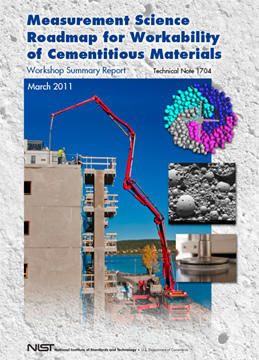Summary
The construction industry is becoming increasing reliant on pumping for the placement of concrete; thus, implying that a concrete must have the desired early age performance as specified by the engineer. This project will remove major technical barriers by providing the industry with measurement science tools to specify, qualify, and assure the pumpability of concrete at the job site. The technical plan will address the two major physical phenomena associated with pumping failures: lubrication and dynamic segregation. Standard test methods, SRMs (Standard Reference Materials) and sensors will be incorporated into industry practice guides that will provide the industry with predictive and quality control tools.
Description

Objective - Provide the industry with measurement science tools to predict whether a concrete can be pumped, with SRMs (Standard Reference Materials) to calibrate concrete rheometers and with tools for quality control in the field.
What is the new technical idea? Fresh concrete is intended a concrete after it is mixed but before it sets. The new technical idea is to develop measurement science tools to predict pumpability of concrete. Pumping is the most common method to place concrete, but no reliable measurement tool exists to ensure that a grout or concrete is pumpable. The American Concrete Institute (ACI) does not have a definition of the term. The major problem is a lack of metrologies that specify the rheological properties to guarantee the concrete performance and service life prior to pumping. A 2011 workshop at NIST [1] identified the critical measurement science barriers to predicting pumping performance: 1) the critical rheological parameters for successful placement, e.g. pumping, must be identified; 2) quality control of fresh concrete for any application or method of delivery (not just pumping) requires development of sensors and test methods; 3) to reduce the cost of production and improve sustainability, the constituents of the concrete or grout need to be selected to ensure that the desired fresh and hardened material performance are obtained. This project will address the first two issues by focusing in three tasks: 1) a high through-put rheometer as a quality control sensor for all concretes, no limited to pumping; 2) develop test methods to predict pumpability of grouts and later apply this knowledge to pumpability of concrete; 3) SRMs for concrete to ensure technology transfer to the industry that would provide tools for performance control. All three areas will advance measurement tools for the construction industry to predict flow and pumpability of concrete in a less empirical way than it is done today.
This project will address the first two barriers through three tasks: 1) develop a novel rheometer (high-throughput), based on a previous exploratory project, to facilitate quality control in the field; 2) Identify how the rheological properties of grout and concrete are related to slippage and dynamic segregation via measurements and simulation; 3) finalize a series of SRMs for use in calibrating concrete rheometers and transfer the SRM to the industry through round-robins and presentations. This will complete NIST role in developing paste, mortar, and concrete SRMs to industry for calibrating rotational rheometers.
What is the research plan? The research plan is divided into three tasks: 1) Development of a high-throughput rheometer for quality control tool in the field; 2) Prediction of pumpability of grouts; 3) Development of the concrete SRMs for rheometer calibration and maintenance of already developed SRM 2492 (paste) and 2493 (mortar).
In FY2012, an exploratory project in collaboration with Dr. Nicholas Dagalakis (EL-Div. 735) was successful in developing the proof-of-concept high throughput rheometer. The plan is to build on this research investment with Dr. Dagalakis's rheometer design, to design a prototype that could be tested in the field. This unique system, once finalized, will be a rheometer that uses disposable specimen holders to measure concrete rheology for the ready mix, precast, and pumping industry to optimize the rheological properties of the concrete mixture at every stage of the process up to placement, thus reducing failure rates to improve costs.
To address this, NIST has built an instrumented pumping station and has rheometers and simulation models that together could provide the measurement science tools to predict the pumpability of a grout. Two main issues were identified as the major contribution to pumpability: slippage on the walls of the pipe and dynamic segregation of concrete components under flow. Both phenomena will be addressed in this project in order to develop methodologies to predict pumpability of grouts, through experimental tests and models. To extend this approach to predicting pumpability of concrete, collaboration with industry will be necessary, as NIST does not have the capability to pump concrete. This will be achieved by identifying concrete manufacturers, i.e. ready mix plants, and field testing opportunities to conduct concrete pumping test.
Building upon the recent development of SRM 2492 and SRM 2493 for cement paste and mortar rheology, respectively the concrete SRM will be produced using a combination of modeling and experimental measurements. The "sand" and "gravel" for the concrete SRMs is composed of two sizes of glass beads. Technology transfer will be organized in collaboration with the American Concrete Institute (ACI), Technical Committee 238 the CRÈME consortium, AASHTO and Florida DOT.
Referenced Documents - Ferraris C.F., Martys N.S., "Measurement Science Roadmap for Workability of Cementitious Materials, Workshop Summary Report", NIST TN 1704, March 2011

